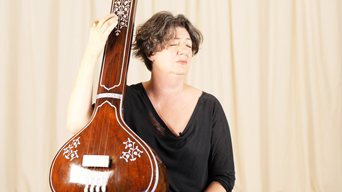Course Description
Ancient Hindu scriptures and contemporary scientists agree: the universe is composed of sound vibration. That includes us. For this reason, yogis across the centuries have harnessed the power of sound to fuel their yoga practice. Traditionally chanting and deep listening held a central role in yogic practice in India. When yoga migrated to the west the physical practice of asana was emphasized and the place of nada anusandhana (yogic sound practice) faded into the background. In recent years, however, there has been a resurgence in yogic chant in studios across the country for its reputation as the simple, quick, easy yogic path. As powerful as ever, the yogic sound practices of invocation, mantra, devotional chant and deep listening are being re-discovered for their ability to help us cope with the challenges of our live today.
What you will receive
- Lifetime access to over 15 hrs of video instruction
- Downloadable .pdfs and illustrations
- Immediate feedback on comprehension through online assignments
- Library of practical exercises
- Desktop, iOS and Android compatible formats
- Certificate of completion from Naada Yoga
Instructor Bio
 Ann Dyer has explored sound and music for over thirty years as a concert and recording artist, yoga practitioner, student of Hindustani vocalization and teacher of sound within the yoga tradition.
Ann Dyer has explored sound and music for over thirty years as a concert and recording artist, yoga practitioner, student of Hindustani vocalization and teacher of sound within the yoga tradition.
Dyer has performed extensively throughout the U.S., India, Brazil, Mexico, and Canada and has released three critically-acclaimed CDs, Ann Dyer & No Good Time Fairies, When I Close My Eyes, and Revolver: A New Spin, which received recognition as one of the Top Ten Recordings of the year by the Village Voice. Her music has been acclaimed for its originality and a subtle use of sound that “grabs you in the gut while it messes with your mind” (The Metro). She has composed and performed soundtracks for two Rodney Yee DVDs released on the Gaiam label, AM Yoga and Five-Day Ashtanga.
Ann’s teaching of the yoga of sound encourages philosophical understanding, skillful practice and experiential knowledge. Her teachings reveal the effects of sound on the material body, physiology, emotion, intellect and the realization of spirit. Topics covered include sanskrit, Vedic mantra, tanrtric mantra, bhakti yoga, naada yoga, the mystical foundations of classical Indian music and the incorporation of sound into one’s personal practice and yoga classes.
Ann is director of Mountain Yoga in Oakland, CA and is on the faculty of Piedmont Yoga Studio’s Deep Yoga Program. Her current musical project VAK: Song of Becoming is a full-length, multi-disciplinary concert built on the sound principles and practices of yoga, commissioned by the Yerba Buena Center for the Arts in San Francisco for performance in September of 2013.
Course Materials
Course Content
Introduction
-
(L) What is Sound Yoga?
-
(L) About this course
-
(L) Challenges and benefits
-
(L) Lecture conclusion
-
(L) Getting the most out of this course
-
(T) Learn Saraswati Invocation
-
(T) What is your sound story?
-
Review
-
Home Practice
-
Supplemental Materials
-
(T) Why do we chant?
-
(T) From Surf to Samadhi: One Girl’s Story of the California/Chant Connection
- (L) What is Sound Yoga?
- (L) About this course
- (L) Challenges and benefits
- (L) Lecture conclusion
- (L) Getting the most out of this course
- (T) Learn Saraswati Invocation
- (T) What is your sound story?
- Review
- Home Practice
- Supplemental Materials
- (T) Why do we chant?
- (T) From Surf to Samadhi: One Girl’s Story of the California/Chant Connection
Sound Emotion
-
(L) Music
-
(L) Bhakti Yoga
-
(L) Lecture conclusion
-
(T) Sargam: Building Blocks of Indian Music
-
(T) Kirtan: A Chant to the Goddess
-
(T) Kirtan: Maha Mantra. Learn the chant.
-
(T) Kirtan: Maha Mantra. Use of Tempo.
-
(T) Kirtan: Maha Mantra. Bhav Exercise.
-
(T) Raga: Shifting Mood and Mind thru Melody
-
(T) Kirtan: Ananda, Ananda
-
(T) Kirtan: Om Namah Shivaya
-
(T) The Power of Melody: Moving from Japa to Kirtan
-
Home Practice
-
Supplemental Materials
-
Assignment
- (L) Music
- (L) Bhakti Yoga
- (L) Lecture conclusion
- (T) Sargam: Building Blocks of Indian Music
- (T) Kirtan: A Chant to the Goddess
- (T) Kirtan: Maha Mantra. Learn the chant.
- (T) Kirtan: Maha Mantra. Use of Tempo.
- (T) Kirtan: Maha Mantra. Bhav Exercise.
- (T) Raga: Shifting Mood and Mind thru Melody
- (T) Kirtan: Ananda, Ananda
- (T) Kirtan: Om Namah Shivaya
- (T) The Power of Melody: Moving from Japa to Kirtan
- Home Practice
- Supplemental Materials
- Assignment






